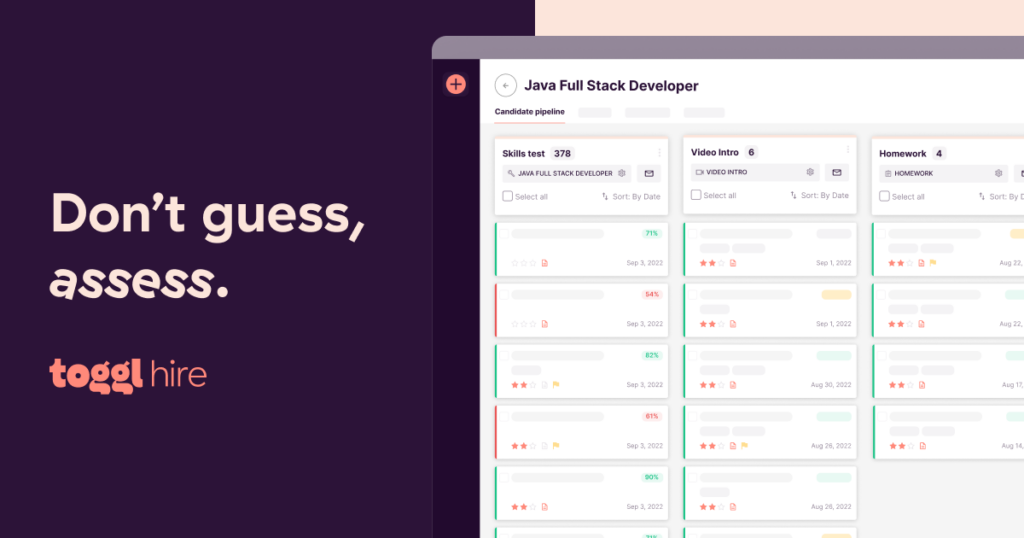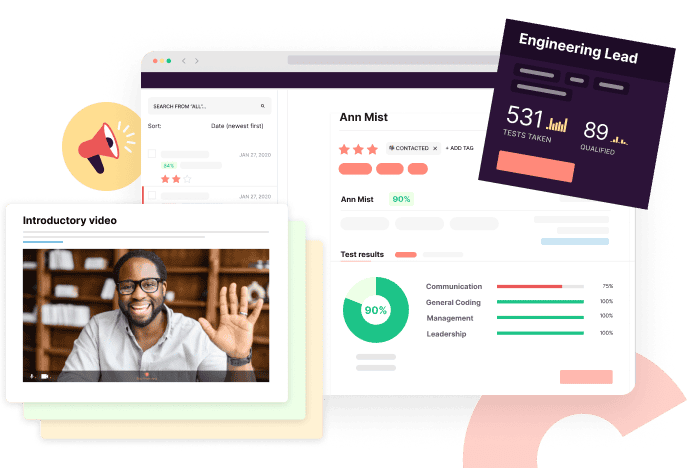To find a hidden treasure, you need a map. To optimize your talent management processes, you also need a map, albeit one that is less exciting.
For any business to succeed nowadays, you need a team with the right skills, but there’s only one problem: those right skills change so fast that it’s hard to keep up with the most in-demand ones for the workplace of the future.
The solution is simple: skills mapping.
Skills mapping means creating a map of your team’s skills, so you can determine if they have the skills needed for your business and, if not, what development opportunities there are for them.
If you’re in desperate need of filling skills gaps or hiring to ensure your team is full of people with the right skills, join us as we show you the A-Z of skills mapping.
TL;DR — Key Takeaways
Skills mapping is the process of identifying and documenting the key skills of an individual or team to see if they have what it takes to achieve business goals in your company.
Skills mapping helps with workforce planning. It lets you visualize competencies and identify skill gaps (and see who is a good fit for future leadership roles), create better hiring processes, engage your employees, and engage in talent development more effectively.
To create a skills map, first define your objectives. Then, choose a skills model and map the skills to individual roles and teams. Finally, assess those skills with tools such as Toggl Hire.
To do skills mapping effectively, it’s important to use expert-created skills tests based on real-world, on-the-job skills, be objective, and centralize your skills mapping data.

What is skills mapping?
Skills mapping is the process of identifying, documenting, and assessing the skills of an individual or a team in an organization.
With skills mapping, a business can categorize and identify the skills of its team members and ensure they’re aligned with its organizational performance goals.
Also, it helps predict your future hiring needs and prevents skills shortages.
Benefits of skills mapping
Skills mapping is an extremely useful HR tactic that helps businesses gain valuable hiring and talent development insights, no matter if you want to upskill existing employees or hire new ones.
However, the real benefits depend on what your goals are and how you go about developing a skill mapping plan. To help you plan your efforts, explore some of the unique benefits of skills mapping to see how this tool might fit into your hiring and performance management processes.
Improved workforce planning
Skills mapping helps you determine whether your team currently has the skills relevant for achieving your future organizational goals.
Whether creating an actual map to fill skill gaps in your existing workforce or a skills matrix to measure the skills and competencies of existing employees, it helps you measure your team’s current technical skills and compare them against your needs in the future.
How so?
First, it ensures that people with the right technical skills are in the right roles. With that information in hand, you can form an actionable hiring plan for the future to close those skills gaps before they become costly canyons that are harder to bridge, such as skills shortages and mismatches.

Visualize competencies
Having a skills map for your business is like having a recipe book before setting out to bake a cake.
With the right skills matrix or map in hand, you can find out if you have all the right ingredients before starting (and not give up once you reach the second paragraph of the recipe because you realize you’re missing half the ingredients and need to rush to the store).
In this context, you can think of a skills map as a visual representation of employee skills. By looking at the map, you can see if each employee has the skills relevant to their roles and the future goals of your business.
Also, you find out where their strengths and weaknesses are, which helps develop targeted training programs, upskilling, succession planning, and overall recruitment efforts.
Better hiring processes
Skills mapping improves your hiring efforts by showing you the exact skills you need in new roles. Instead of hiring because you need a new developer on your team, you can start with a skills mapping exercise to determine the skills you have vs. the ones you’re missing.
For example, perhaps you do need a new developer, but what’s really stalling product advancement and new feature development is a lack of front-end skills. Because you’ve assessed other developers’ skills, you can see you’re severely lacking in React proficiency specifically.
As a result, you can create more detailed and accurate job descriptions, choose and build better skills assessments, screen candidates more quickly and efficiently, and ultimately, make better hiring decisions.
Increased employee engagement
Skills maps aren’t just for you; they’re great for your employees, too!
When you create skills maps, you can show your employees what their current skills are and where you want them to be. This gives them a clear understanding of their performance and sets expectations for the future, both while they’re working for your company and throughout the rest of your career.
Use this as an opportunity to reflect on an employee’s personal development goals and show recognition and appreciation for the work they do.
Depending on the results of the exercise, make decisions that will keep them engaged, like giving them more autonomy in deciding where their role and career path are headed.
More effective talent development
Having a skills mapping process takes your hiring from shooting in the dark to hitting the bullseye every time (okay, maybe not every time, but pretty close!).
Listing out the essential skills of your employees helps create targeted talent development plans, and instead of looking short-term at filling an individual role, you can focus on long-term talent acquisition and development for your business.
How to create a skills map
There are many different ways to create a skills map, especially with so many skills management software offering actual tests and skills matrices to help. The two key factors are: which skills model you use and how you want to visualize the end product.
A skills matrix can come in handy here. It helps you identify skill gaps in just five steps, and it’s a highly efficient way to map out the desired and existing skills in your team.
Want to actually create a skills matrix or map as you walk through these steps? Download our free skills matrix template (no email required)!

The great news is that you don’t need expensive skills management software to create skills maps or skills matrices. Here are the step-by-step instructions you can follow today for free.
1. Define the objectives
Honestly, you don’t always need a reason to create skills matrices or engage in skills mapping. Sometimes, identifying skills gaps or assessing the skill sets of your current workforce is enough.
However, having a specific objective can help quite a bit if your goal is to get measurable results out of the exercise.
For example, the goal of your skills mapping process could be to find skills and talent gaps in an effort to increase productivity, predict future hiring needs to reduce your hiring costs or conduct skills assessments to determine your existing skills as part of having a competitive advantage in your industry.
Ultimately, it’s important to know what you want to achieve, as this will guide your skills mapping process, help you set the right goals, and measure your progress.
2. Choose a skills model
To gain valuable insights from your skills maps, you need to choose the skills model that best matches your needs from the previous step. A skills model is a framework for structuring and categorizing skills and competencies for a role or department.
There are different types of skill models you can choose, each with its pros and cons. You’ll find these ones handy when starting your skill mapping process:
The Korn/Ferry Lominger Leadership Architect Competency Model: Comprehensive, research-based, and flexible, but also complex, requires lots of resources, and tends to have problems with subjectivity.
SIGMA Leadership Competency Network: Simple, practical, focuses on key leadership skills, but also limited in depth and customization options, there are possibilities of oversimplification, and it may not address new leadership challenges.
HRSG Behavioral, Technical, and Leadership Competency Models: Comprehensive, customizable, and based on research, but also complex, resource intensive, and presents possibilities for subjectivity.

3. Assess skills
Before actually mapping skills, you need to conduct skills assessments. There are many ways you can do this, such as performance reviews, self-assessments, personality tests, or pre-made skills assessment tests like Toggl Hire.
To ensure your skills mapping efforts work out, the skills assessment must be accurate. If the reported employee skills are embellished and exaggerated, nobody wins, as you won’t get an accurate representation of your employees’ skills, and they won’t know where they have opportunities to grow and improve.
So, ensure you’re using expert-created skills tests that are backed by real-world data and on-the-job scenarios. This applies to whether you’re assessing hard skills like copywriting or soft skills like attention to detail.
4. Map skills to roles and teams
Once you have a list of skills, your human resources team can map them to roles and teams within your company. For example, project management can be mapped to a development team lead, a product manager, a CMO, and others, while Python can only be mapped to a developer.
This paints an accurate picture of where you currently stand with available skills in your team. It also helps with resource allocation in the future.
Tips for effective skills mapping
The steps listed above are great starting points to creating a skills mapping strategy, but they’re just that — starting points. To assess employees’ skills accurately, come up with better training programs and ultimately, build a more skilled workforce, you’ll want to use the following tips.
Use expert-created skills tests for soft and technical skills
We can’t highlight the importance of this enough: To ensure you test for the right skills, the tests you use should be crafted by experts. In other words, you probably won’t be able to identify the required skills with a simple test your HR team creates.
To get reliable results, use tests created by experts. Tools such as Toggl Hire help you test for hard skills such as development, marketing, design, and many others. At the same time, you can test soft skills such as communication, conflict resolution, empathy, and others.

These tests are standardized, with expert-vetted questions and grading scales, ensuring your skill map is based on fairness, accuracy, and attention to detail.
Be as objective as possible
There’s no room for sugarcoating in skills mapping. When determining if someone has the necessary skills for a role, you don’t want to turn a blind eye if someone performs poorly with particular skills.
Being objective and impartial with skills mapping ensures you don’t play favorites and that each employee is assessed and graded based on what they can really do. Objectivity leads to better skills maps, higher accuracy, and better employee development programs.
Centralize skills data
To support talent development initiatives, have all your skills data and skills maps in one central location. Easy access to information such as available and required skills is helpful for HR teams, managers, and the C-level.
Also, having a centralized location for data can make your internal business and hiring practices more transparent, as everyone can access the same data whenever they need it.
Aside from helping you develop targeted training, this information can improve employee engagement and morale by publicly highlighting the values of individual employees (just be careful about sharing exact, in-depth results).

Fill a skills gap with Toggl Hire
Skills mapping is important for the present and the future of your company, and its value goes beyond hiring. With skills mapping as an HR tool, you can accurately predict your talent needs and come up with strategies to find the right people to crush your business goals.
At Toggl Hire, we can help you create detailed and accurate tests so you can find out what skill sets your teams have and what they need to get to the next level of their professional development. You don’t have to work hard to get started – just browse through our test library to find the best test for your roles.
Create your free account to get started today!

Mile is a B2B content marketer specializing in HR, martech and data analytics. Ask him about thoughts on reducing hiring bias, the role of AI in modern recruitment, or how to immediately spot red flags in a job ad.








